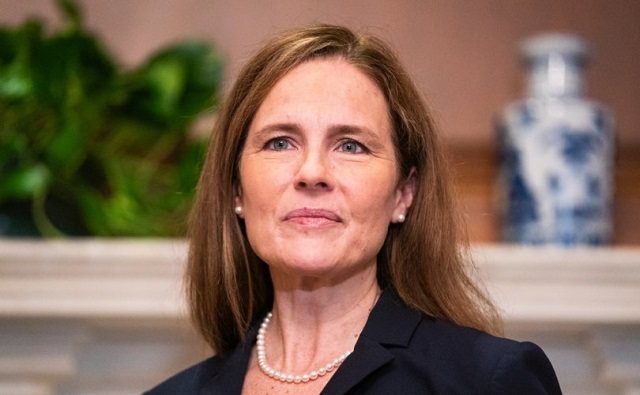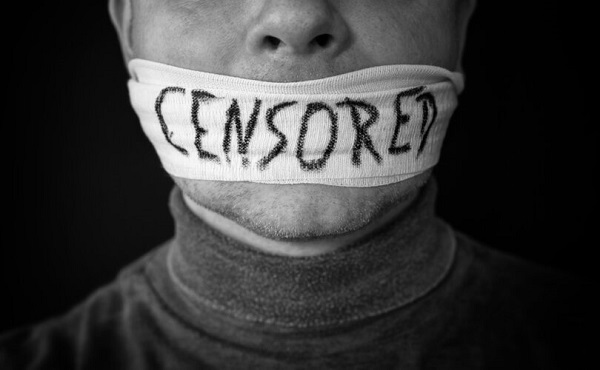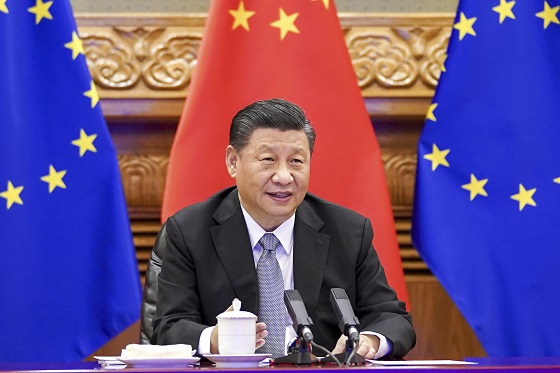International
Supreme Court unanimously rules that public officials can be sued for blocking critics on social media

From LifeSiteNews
Supreme Court Justice Amy Coney Barrett Justice noted that the personal social media accounts of public officials often present an ‘ambiguous’ status because they mix official announcements with personal content.
The United States Supreme Court ruled unanimously on Friday that government officials who post about work-related topics on their personal social media accounts can be held liable for violating the First Amendment rights of constituents by blocking their access or deleting their critical comments.
In a 15-page opinion, Justice Amy Coney Barrett noted that the personal social media accounts of public officials often present an “ambiguous” status because they mix official announcements with personal content.
The court ruled in two cases where people were blocked after leaving critical comments on social media accounts of public officials.
The first case involved two elected members of a California school board — the Poway Unified School District Board of Trustees — who blocked concerned parents from their Facebook and Twitter accounts after leaving critical comments.
The court upheld the 9th U.S. Circuit Court of Appeals ruling that said the board members had violated the parents’ free speech rights.
The second case before the court concerned James Freed, Port Huron, Michigan’s city manager who had blocked constituent Kevin Lindke from commenting on his Facebook page after deleting his remarks about the city’s COVID-19 pandemic policies.
Lindke believed that Freed had violated the First Amendment by doing so and sued Freed.
Freed maintained that he launched his Facebook page long before becoming a public official, arguing that most of the content on his account concerned family-related matters.
Justice Barrett explained:
Like millions of Americans, James Freed maintained a Facebook account on which he posted about a wide range of topics, including his family and his job. Like most of those Americans, Freed occasionally received unwelcome comments on his posts. In response, Freed took a step familiar to Facebook users: He deleted the comments and blocked those who made them.
For most people with a Facebook account, that would have been the end of it. But Kevin Lindke, one of the unwelcome commenters, sued Freed for violating his right to free speech. Because the First Amendment binds only the government, this claim is a nonstarter if Freed posted as a private citizen. Freed, however, is not only a private citizen but also the city manager of Port Huron, Michigan — and while Freed insists that his Facebook account was strictly personal, Lindke argues that Freed acted in his official capacity when he silenced Lindke’s speech.
Barrett concluded:
When a government official posts about job-related topics on social media, it can be difficult to tell whether the speech is official or private. We hold that such speech is attributable to the State only if the official (1) possessed actual authority to speak on the State’s behalf, and (2) purported to exercise that authority when he spoke on social media.
In the end, the high court sent Lindke’s case back to the Sixth Circuit Federal Appeals Court for a second look.
Perhaps reflecting continued ambiguity following the court’s ruling, both defendant Freed and plaintiff Lindke declared victory.
“I am very pleased with the outcome the justices came to,” Freed told ABC News in a statement. “The Court rejected the plaintiff’s appearance test and further refined a test for review by the Sixth Circuit. We are extremely confident we will prevail there once more.”
Lindke was more effusive and told ABC News that he was “ecstatic” with the court’s decision.
“A 9-0 decision is very decisive and is a clear indicator that public officials cannot hide behind personal social media accounts when discussing official business,” said Lindke.
Legal experts called attention to the persistence of gray area in the law regarding social media due to the narrowness of the court’s decision.
“This case doesn’t tell us much new about how to understand the liability of the 20 million people who work in local, state, administrative or federal government in the U.S. … just that the question is complicated,” Kate Klonick, an expert on online-platform regulation who teaches at St. John’s Law School, told The Washington Post.
Katie Fallow, senior counsel for the Knight First Amendment Institute at Columbia University, told the Post that the court’s ruling does not sufficiently address public officials’ widespread use of personal “shadow accounts,” which constituents often perceive as official.
Fallow said the court was “right to hold that public officials can’t immunize themselves from First Amendment liability merely by using their personal accounts to conduct official business.”
We are disappointed, though, that the Court did not adopt the more practical test used by the majority of the courts of appeals, which appropriately balanced the free speech interests of public officials with those of the people who want to speak to them on their social media accounts.
According to The Hill, the Biden administration and a bipartisan group of 17 states and National Republican Senatorial Committee sided with officials, arguing in favor of their blocks, while the ACLU backed the cons
Friday’s ruling is only the first of several this term that deal with the relationship between government and social media.
“On Feb. 26, the justices heard argument[s] in a pair of challenges to controversial laws in Florida and Texas that seek to regulate large social-media companies,” explained Amy Howe on Scotusblog.com. “And on Monday the justices will hear oral arguments in a dispute alleging that the federal government violated the First Amendment by pressuring social media companies to remove false or misleading content. Decisions in those cases are expected by summer.”
International
Pope Francis Got Canadian History Wrong

From the Frontier Centre for Public Policy
Pope Francis’s careless genocide comment gave activists the fuel they needed, and Parliament rushed to judgment without examining the facts
Many Catholics will grieve the death of Pope Francis. But not all.
That’s because Francis was arguably the most political Pope in recent memory. Depending on your definition, he was either a socialist or a communist. There wasn’t a leftist leader or cause he didn’t embrace, and few conservative ones he supported. He regularly weighed in on progressive issues like climate change and offered political opinions, even when he seemed to lack a full understanding of the topic.
One such issue was Canadian history.
In 2021, the Tk’emlúps te Secwépemc First Nation announced that ground-penetrating radar had detected anomalies near the former Kamloops Indian Residential School, interpreted by some as possible unmarked graves of children. The claim made international headlines and sparked widespread outrage, although no remains have ever been unearthed.
During a late-night flight, the ailing octogenarian Pope, seemingly charmed by a young reporter, described Canada’s residential schools as “genocide,” a departure from his earlier, carefully prepared statement, which made no such accusation and echoed apologies offered by his predecessors. Those statements expressed regret for harm done but also acknowledged the good work of countless priests and nuns who dedicated their lives to educating Indigenous children.
In a moment of startling informality, Pope Francis appeared to accept the now-disputed Kamloops story as fact, effectively accusing thousands of priests, nuns, teachers and support workers—both Indigenous and non-Indigenous—of committing genocide. He appeared to accept at face value the now-disputed Kamloops story of secret burials and sinister deaths. In doing so, he didn’t just slander individuals—he changed Canadian history.
“Yes, it’s a technical word, genocide. I didn’t use it because it didn’t come to mind. But yes, I described it. Yes, it’s a genocide,” Francis said in July.
Indigenous activists wasted no time. They realized those words were exactly what they needed. Their initial genocide motion in Parliament—based on the Kamloops claim of 215 hidden graves—had failed. But with the Pope’s remarks, the political climate shifted.
NDP MP Leah Gazan led the charge. She had introduced a motion after the Kamloops claim first surfaced. She returned the following year with the same proposal, and this time, the Pope’s comments gave it new weight.
The motion declared Canada’s treatment of Indigenous children in residential schools as genocide—a declaration that, while not legally binding, carries moral and political weight. It passed quickly and without debate.
The irony? The very same activists who had earlier promoted deeply anti-Catholic conspiracy theories about atrocities committed by priests and nuns—stories that fuelled church burnings across Canada—were now treating every word from the Pope’s mouth as gospel. Non-believers appeared to be embracing some version of papal infallibility (a Catholic doctrine that, in specific cases, the Pope’s declarations are considered free from error)—if only when it suited them.
Meanwhile, Parliament failed to do its homework. Elected representatives never seriously investigated the many holes in the Kamloops story. Despite the global headlines, no excavations at the Kamloops site have confirmed the presence of remains. Multiple independent experts have raised concerns about the methodology and public interpretation of the findings.
Yet MPs allowed themselves to be swayed. Incredibly, they spent just 47 seconds debating and approving a motion that condemned their own country for genocide.
Much has been written about the lack of evidence behind the Kamloops claim. Suffice it to say, the “remains of 215 children” turned out to be an old sewage trench. Think about that—our nation was convicted of genocide based on a sewage trench.
Earlier popes took a more thoughtful approach. They acknowledged that wrongs were committed, that abuse occurred, and that some individuals within the system failed. But they also recognized that the goal of educating Indigenous children was legitimate, and that many students gained literacy and language skills that served them for life.
Those are the papal perspectives worth remembering.
Pope Francis did much good in his life, and many will reflect fondly on his legacy. But when it comes to Canada, his careless and misinformed comments on genocide did real harm. Let’s hope the next Pope is more careful with his late-night musings.
Brian Giesbrecht is a retired judge and a senior fellow at the Frontier Centre for Public Policy.
Censorship Industrial Complex
Is free speech over in the UK? Government censorship reaches frightening new levels

From LifeSiteNews
By Frank Wright
Instead of changing policies which threaten the collapse of Western civilization, the liberal-global governments prefer to make public opposition to their politics a crime.
The UK’s crackdown on free speech continues, with two online platforms withdrawing over censorship concerns – whilst liberal-critical speakers are banned from entering Britain, and even arrested on arrival.
Following the introduction of laws which could see online platforms fined millions of pounds, free speech social media company Gab and video sharing platform Bitchute have withdrawn their services from UK users.
As Reclaim the Net, a UK-based online freedom campaign group, said on March 28:
“The British government has begun aggressively extending its censorship regime beyond its borders, invoking the sweeping powers granted by the Online Safety Act 2023 to demand compliance from foreign-based platforms.”
Bitchute withdrew its services from UK users “over online censorship laws,” as the Free Speech Union reported on April 10. Gab’s statement, published on its UK domain, said the company was acting to protect British users from being jailed for posting on its platform:
After receiving yet another demand from the UK’s speech police, Ofcom, Gab has made the decision to block the entire United Kingdom from accessing our website.
This latest email from Ofcom ordered us to disclose information about our users and operations. We know where this leads: compelled censorship and British citizens thrown in jail for ‘hate speech.’ We refuse to comply with this tyranny.
The UK government claims its laws support “online safety” – but as Reclaim the Net explains, “critics argue … the term … is being used as a smokescreen for state-sanctioned thought control.”
The future of information in Britain looks bleak, as one UK commentator said, promising a “TV version” of the internet – sterilized by UK government media watchdog Ofcom:
“Unless the White House really forces Britain to do it, Ofcom will not be abolished, because the mainstream parties approve of it and no party that doesn’t will be allowed anywhere near power.”
Millennial Woes concludes that there is likely a “hit list” of further online platforms to be taken down in order, beginning with video outlets Odysee and Rumble, the messenger service Telegram, then the free speech publisher Substack – and on to Elon Musk’s X.
Woes warns:
“If allowed to continue in its current mode, Ofcom will take down the platforms it wants to, then tame the others by hook or by crook. The Internet in Britain will be a homogenised, redacted farce – a pathetic ‘TV version’ of what people in more civilised countries have.”
Cambridge professor arrested
The charge of “state-sanctioned thought control” is reinforced by the arrest – on Good Friday –-of a Palestinian Christian and Cambridge University professor at London’s Heathrow Airport. The reason for Professor Makram Khoury-Machool’s detention was that he has spoken out against Israel’s war in Gaza, as reports from the UK said.
“Keir Starmer’s long and intensifying war on pro-Palestine, anti-genocide speech through the misuse of the Terrorism Act … has continued to escalate,” noted UK outlet Skwawkbox, which covers stories such as this – neglected by the mainstream press “because it doesn’t fit their agenda.”
Professor Khoury, whose speech was criminalized under anti-terror laws, had in the past co-founded an anti-extremism institute in 2016 at Cambridge University.
British left-populist George Galloway responded on X (formerly Twitter), saying the arrest of this “gentle, devout moderate academic father” suggests that the “government has declared war on its own citizens, that liberty is dead in this land, and that Britain is no longer a safe country.”
Galloway’s warning of “It can happen to you. And it will” came a day after reports that a French philosopher noted for his outspoken criticism of mass migration had been banned from entering the UK.
French anti-migration speaker banned
Renaud Camus is the author of The Great Replacement – coining a term now used to describe the liberal-global policy of the replacement of Western populations via mass immigration.
The “great replacement” is routinely “debunked” by the ruling elite as a “conspiracy theory.” As Camus once said to Britain’s Matt Goodwin, “How can it be debunked when it is evident in every street?”
He was due to speak at a “remigration conference” in England on April 26. Organized by the nationalist Homeland Party, it is dedicated to the discussion of policies similar to those now being enacted by the Trump administration.
According to the Daily Telegraph, Camus was denied entry to the UK by government order.
In an email seen by The Telegraph, the Home Office informed Mr Camus that he had been denied the electronic travel authorisation (ETA) needed to enter Britain.
‘Your presence in the UK is not considered to be conducive to the public good,’ the email read.
The Telegraph reports that Mr Camus, “who is gay and has advocated for non-violence,” supplied one convincing explanation for his treatment:
[He] told The Telegraph that ‘of all the European governments guilty’ of allowing unchecked migration, ‘the British government is one of the guiltiest’.
‘No wonder it does not want me to speak,’ Mr Camus added.
The fact the British government is banning speakers who promote policies now being enacted with widespread support in the United States has not only provoked criticism – it may derail UK/U.S. trade negotiations.
Days ago, Vice President JD Vance warned UK Prime Minister Keir Starmer that Britain will get no deal with the U.S. over tariffs if its “hate speech” laws remain in place.
“Sir Keir Starmer must embrace Donald Trump’s agenda by repealing hate speech laws in order to get a trade deal over the line, a Washington source has told The Independent.”
A “Washington source” told the UK-based Independent, “No free speech, no deal. It is as simple as that.”
Vance has been a stern critic of British and European moves towards increasing censorship and the suppression of freedom of opinion, describing it in his February Munich speech as a “threat” to democracy “from within” Western Europe – and one which is led by its liberal-globalist governments.
Vance is reportedly “obsessed by the fall of Western civilisation,” The Independent’s Washington source explained. It is clear that Vance believes that this fall is very much a threat created by the political decisions of governments like Starmer’s.
The use of “hate speech” and “anti-terrorism” laws in these cases shows how the UK state-sanctioned suppression of speech affects anyone – from the left, right, or from the Christian faith – who criticizes the policies of the government.
These are not fringe extremist views, but those held by increasing numbers of ordinary people in Britain and throughout the Western world. Instead of changing policies which threaten the collapse of Western civilization, the liberal-global governments prefer to make public opposition to their politics a crime.
In the case of the British state, its hardline stance to defend its idea of democracy from free speech is now threatening its economic future. The politics and laws celebrated as the guarantee of safety increasingly resemble a form of extremism which will not tolerate debate.
-

 Business1 day ago
Business1 day agoTrump: China’s tariffs to “come down substantially” after negotiations with Xi
-

 Business2 days ago
Business2 days agoHudson’s Bay Bid Raises Red Flags Over Foreign Influence
-

 Business1 day ago
Business1 day agoTrump considers $5K bonus for moms to increase birthrate
-

 2025 Federal Election2 days ago
2025 Federal Election2 days agoCanada’s pipeline builders ready to get to work
-

 2025 Federal Election2 days ago
2025 Federal Election2 days agoMark Carney Wants You to Forget He Clearly Opposes the Development and Export of Canada’s Natural Resources
-

 Business22 hours ago
Business22 hours agoChinese firm unveils palm-based biometric ID payments, sparking fresh privacy concerns
-

 International2 days ago
International2 days agoNew York Times publishes chilling new justification for assisted suicide
-

 2025 Federal Election1 day ago
2025 Federal Election1 day agoCanada’s press tries to turn the gender debate into a non-issue, pretend it’s not happening





